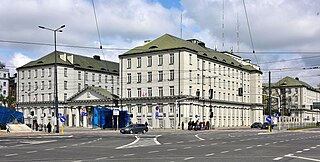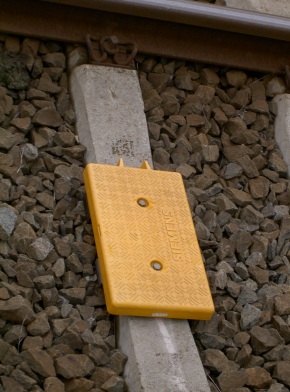Related Research Articles

The International Union of Railways is an international rail transport industry body.

Radio Electronic Token Block is a system of railway signalling used in the United Kingdom. It is a development of the physical token system for controlling traffic on single lines. The system is slightly similar to North American direct traffic control, which unlike RETB does not have a cab display unit.

The Cambrian Line, sometimes split into the Cambrian Main Line and Cambrian Coast Line for its branches, is a railway line that runs from Shrewsbury, England, westwards to Aberystwyth and Pwllheli in Wales. Passenger train services are operated by Transport for Wales Rail between the western terminals of Pwllheli, in Gwynedd, and Aberystwyth, in Ceredigion, and the eastern terminal at Shrewsbury, Shropshire, as part of the Wales & Borders franchise. The railway line is widely regarded as scenic, as it passes through the Cambrian Mountains in central Wales, and along the coast of Cardigan Bay in Snowdonia National Park.

The European Train Control System (ETCS) is a train protection system designed to replace the many incompatible systems used by European railways, and railways outside of Europe. ETCS is the signalling and control component of the European Rail Traffic Management System (ERTMS).

Banedanmark is a Danish company that is responsible for the maintenance and traffic control on all of the state owned Danish railway network.

PKP Polskie Linie Kolejowe S.A. is the Polish railway infrastructure manager, responsible for maintenance of rail tracks, conducting trains across the country, scheduling train timetables, and management of railway land.

Infrabel is a Belgian government-owned public limited company. It builds, owns, maintains and upgrades the Belgian railway network, makes its capacity available to railway operator companies, and handles train traffic control.
The European Rail Traffic Management System (ERTMS) is the system of standards for management and interoperation of signalling for railways by the European Union (EU). It is conducted by the European Union Agency for Railways (ERA) and is the organisational umbrella for the separately managed parts of

A Eurobalise is a specific type of a balise installed between the rails of a railway. Eurobalises are part of the European train control system (ETCS). The balises are pre-programmed and contain information that is read by train antennas. One of their many functions is to allow a train to determine its location.
Siemens Mobility is a division of Siemens. With its global headquarters in Munich, Siemens Mobility has four core business units: Mobility Management, dedicated to rail technology and intelligent traffic systems, Railway Electrification, Rolling Stock, and Customer Services.
Transmission balise-locomotive is a train protection system used in Belgium and on Hong Kong's East Rail line.
European Rail Infrastructure Managers (EIM) is a sector association that represents the interests of European rail infrastructure managers. Members consist of owners/managers of infrastructure from most European/EEA countries.
ERTMS Regional is a simplified and low-cost variant of the European Rail Traffic Management System suitable for train control on lines with low traffic volumes. It is intended to reduce the amount of lineside and equipment required, thus reducing costs, increasing reliability and improving safety for track workers.

Communications-based train control (CBTC) is a railway signaling system that uses telecommunications between the train and track equipment for traffic management and infrastructure control. CBTC allows a train's position to be known more accurately than with traditional signaling systems. This makes railway traffic management safer and more efficient. Rapid transit system are able to reduce headways while maintaining or even improving safety.
Computer-based interlocking is railway signal interlocking implemented with computers, rather than using older technologies such as relays or mechanics.
The European Rail Traffic Management System (ERTMS) is an initiative backed by the European Union to enhance cross-border interoperability and the procurement of signalling equipment by creating a single Europe-wide standard for train control and command systems.

The European Union Agency for Railways (ERA) is an agency of the European Union (EU) that sets mandatory requirements for European railways and manufacturers in the form of Technical Specifications for Interoperability (TSI), which apply to the Trans-European Rail system. The ERA publishes a document summarising the status of the TSIs. The ERA sets common safety targets, common safety methods and common safety indicators, following Directive 2004/49/EC and amendments. The ERA also hosts a number of databases, among which a register of remaining, applicable national rules. One of its primary duties is the development and implementation of the European Rail Traffic Management System (ERTMS).
The European Partnership for Railway Energy Settlement Systems (ERESS) is a partnership of European infrastructure managers that develops, offers and supplies energy settlement system and energy calculation systems for trains.

Nightjet is a brand name given by the Austrian Federal Railways (ÖBB) to its overnight passenger train services.
Bane NOR SF is the Norwegian government agency responsible for owning, maintaining, operating and developing the Norwegian railway network, including the track, stations, and the majority of other infrastructure assets. It took over the operations of Jernbaneverket (railway administration) on 31 December 2016.
References
- ↑ Elsweiler, Bernd (March 2014). "Beyond ETCS – Interoperable interfaces and more" (PDF). IRSE news. Archived from the original (PDF) on 6 September 2017. Retrieved 30 July 2017.
- 1 2 "EULYNX Homepage". EULYNX. Retrieved 23 Nov 2018.
- 1 2 3 Briginshaw, David (29 Sep 2017). "Get ready for the next signalling revolution". International Railway Journal. Retrieved 28 Jun 2017.
- 1 2 Briginshaw, David (28 Jun 2017). "SBB joins Eulynx signalling initiative". International Railway Journal. Retrieved 28 Jul 2017.
- ↑ "EULYNX: a route to standardisation". Global Railway Review. 28 Jul 2017.
- ↑ Briginshaw, David (4 Jan 2018). "Digitalisation: the new driver of railway technology". International Railway Journal. Retrieved 23 Nov 2018.
- ↑ Bane NOR: The Norwegian Railway is on Track Towards a New Future, EIM Rail, 24 September 2021
- ↑ "Trackside Assets Specifications". Europe’s Rail Joint Undertaking. 30 June 2024.